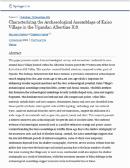| dc.description.abstract | This paper presents results from archaeological surveys and excavations conducted in 2012 around Kaiso Village located within the Albertine Graben part of the Western arm of the Great East African Rift Valley. This area has received limited attention compared to other parts of Uganda. The findings demonstrate that Kaiso contains a previously unexplored archaeological record ranging from the Later Stone Age to the Late Iron Age which is important for addressing broader regional questions and the site's archaeological potential. Kaiso Village’s archaeological assemblage comprises lithic, pottery and faunal remains. The lithic artefacts that dominate the archaeological assemblage broadly include shaped tools, cores and angular fragments. The dominant tools are both end and side scrapers and points. Other lithic materials include flakes and core scrapers, denticulates, burins and core axes identified from these specific attributes interrogated such as lithic typology, technology and raw material types. Analysed materials from the survey and test excavations, suggest the utilisation of a wide range of raw materials such as quartzite, quartz, basalt and chert. This research presents a hitherto unknown area archaeologically despite the lack of absolute dates. The scattered evidence of archaeological materials such as Levallois reduction strategy and points cannot warrant branding the Kaiso assemblage as Middle Stone Age due to the shallow stratigraphy of the excavation units and lack of absolute dating. Instead, the Kaiso assemblage suggests that the site had different periods of cultural occupation, some of which were temporary settlements depicted from the shallow stratigraphy. However, severe erosion evident from the gullies that transverse the landscape and animal grazing due to the large numbers of cattle that were roaming the village and, in most cases, unattended could also explain the shallow stratigraphy as a result of disturbance, while the enormous amounts of lithic debitage in the archaeological assemblage suggest extensive stone tool manufacture at Kaiso. | en_US |

